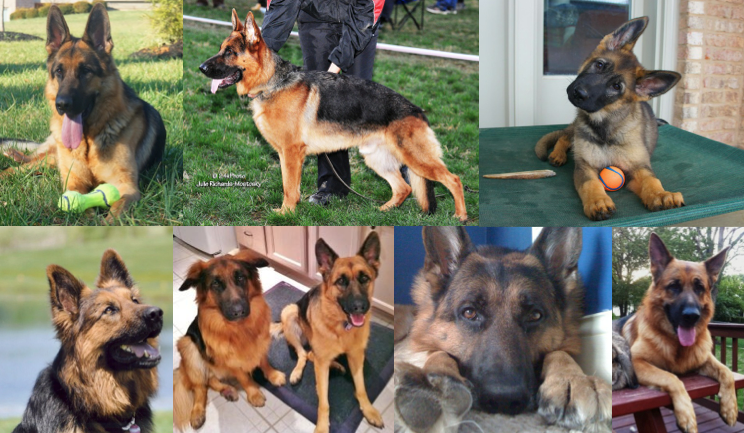The above photos are courtesy of Olewo USA customers.
The German Shepherd Dog is hailed as the world’s leading police, guard and military dog, however, this dependable breed is more than its 9-to-5 job. Consistently one of the United States most popular breeds according to AKC® Registration Statistics, the German Shepherd Dog is also a loving family companion, herder and show competitor.
The German Shepherd Dog originated in 1899 at Karlsruhe, Germany due to the efforts of Captain Max von Stephanitz and others. Derived from the old breeds of herding and farm dogs, the first German Shepherd Dog exhibited in America was in 1907. The fame associated with Rin-Tin-Tin and Strongheart, two members of the breed whose movies played on variations of the boy and his dog theme, shot the popularity of the breed sky-high.
The breed is approachable, direct and fearless, with a strong, muscular body. The GSD may be most colors, but most commonly is black and tan. Slightly long in comparison to its height, the German Shepherd Dog is ideally 23″-25″ (57.5 – 62.5 cm) high. These proportions coupled with the position of the fore and hindquarters producing a far-reaching and enduring gait. Attentive, alert and resilient, the breed is steady of nerve, loyal, self-assured, courageous, and tractable and should never be over-aggressive or shy. For exhibition the coat should be straight, hard, and as close lying as possible, with a thick undercoat.
THE MANY ROLES OF THE GERMAN SHEPHERD
The German Shepherd is easy to train because he is intelligent and has highly developed senses. Specialized trainers can prepare the individual dog to take on one of many roles: defender, drug dog, guard, life-saver, sentry, tracker, army or police dog, dog to lead the blind, or to rescue victims of earthquake and avalanche.
The training of the German Shepherd begins when he is only ten weeks old. At this stage, he takes part in walks and games, during which he learns to respond to his name when commanded by his trainer, to accept the collar and leash, and finally to walk leashed or free.
At the age of eight months, a trainer teaches the GSD how to guard, jump, search, track, refuse bait, and retrieve. His ‘vocabulary” is extended to include an understanding of such commands as ‘go’, ‘stay’, ‘get up’, and ‘lie down’.
The last, difficult training stages are for German Shepherds being educated as defenders or guards. They are taught to deal with intimidating situations such as threatened beatings, and to become used to the sounds of gun-fire. Each dog goes through attack-training. During carefully simulated encounters, the dog is ordered to attack an intruder, which may be a dummy or a properly protected instructor. Once attack-training is completed, the defending or guard dog is assigned to its own handler and attacks only on his command. The training of an army or police dog is based on these principles. Duties may include patrolling, tracking, detecting mines, and protecting military bases.
German Shepherds were first trained as avalanche dogs in 1970. Their highly developed sense of smell and their tough, weather-resistant coats make these dogs the most effective and rapid rescuers of victims of these natural disasters.
CHARACTERISTICS
General Appearance: robust and supple, this slight elongated dog is all muscle. Its dignified bearing and courageousness command respect.
Height: 24″ to 25″ (61 – 63.5 cm) for the adult dog; 22″ to 24″ (55.9 – 61 cm) for the bitch.
Weight: under Canadian standards, 75 to 85 lb (34 to 38.5 kg) for the adult dog, and 60 to 70 lb (27.2 to 31.8 kg) for the bitch. Elsewhere, not specified.
Head: in proportion with the body, clear cut, fairly broad between the ears. Stop barely defined. Muzzle long and strong. Lips are clean and tight. Nose black, muzzle straight. Teeth sound and strong, scissor bite.
Eyes: medium size, almond-shaped, slightly slanting, not protruding, dark brown preferred. Expression alert, highly intelligent and self-assured.
Ears: medium size, broad at the base, set high, carried erect and pointed forward. The ears of young dogs sometimes hang until the sixth months or later, becoming erect with the replacement of the milk teeth. Great care should be taken not to break the cartilage.
Neck: fairly long, strong, well muscled.
Body: chest deep, capacious, but not too broad. Ribs long and well sprung, not too flat. Belly firm held, not paunchy. Back straight. Flanks broad, strong and well muscled. Croup long and slightly sloping. Shoulders long, oblique, well laid back. Loin broad and strong.
Tail: bushy, set low rather than high.
Forequarters: legs straight, elbows neither wide apart nor sloping.
Hindquarters: thighs broad, muscular. Hocks bent, firm and vigorous.
Coat: an outer and inner coat, both thick. Stiff, thick, flat, coarse hair. Breeching near the thighs. Hair length varies.
Color: black with brown markings, tan, light gray with black and dark saddle. Small white markings on the chest or inside the legs are permissible.
PRACTICAL INFORMATION
The German Shepherd needs daily brushing and only one or two baths a year. He may suffer from chronic eczema, keratitis (inflammation of the cornea), and hip dysplasia (malformation of the hip joint), a hereditary affliction which becomes apparent about the age of four month. To avoid buying a sickly dog, always go to a reputable breeder.
To make sure your GSD can enjoy optimal health, be vibrant and thrive, all-natural dog supplements should be added to his diet for added natural nutrition. A carrot dog food supplement is an excellent source of natural nutrition and offers amazing health benefits for dogs such as a quick cure from dog diarrhea, healthy digestion, natural deworming, healthy skin and coat, and immune system health. A is also recommended because red beets are a nutritional powerhouse, a great natural detoxifier to prevent dog allergies, and have anti-inflammatory compounds that can help lower the risk of inflammatory-driven diseases. Red beets are the most powerful antioxidant and can help protect against disease and certain cancers.
Since your German Shepherd does not need a bath very often, an all-natural skin and coat care spray is ideal for general care in-between baths. Choose a quality spray, preferably one that naturally kills bacteria, fungi and viruses to prevent skin problems in dogs and helps bring relief to the occasional itchy dog.


Charrece Blackmon says
A stunning breed. Dedicated to their owner, loyal and loving. This wonderful breed has so many positive attributes!
Melissa Pevy says
Amazing dogs. They really love having a job to do
Janet Oppedal says
Great dogs! I grew up with them, my sister owns them and they have saved her live stock from the neighbors dogs, they have kept her home from being robbed.. they are overall a great dog with a huge heart.
Tami Welch says
I’ve known several over my lifetime and all were dependable, loyal family members. They are content to lie quietly hanging out with you, but are always ready to ‘GO’ when you are. My hubby grew up with them and I have a feeling we’ll end up with one when the timing is right.
Jennifer Pointer says
Absolutely beautiful dogs. Loyal and smart.
Janis Schell says
I have always had good experiences with the breed.They love beeing part of the family.
Tina Anderson says
Such loyal and beautiful animals!